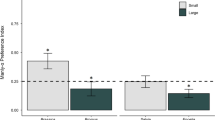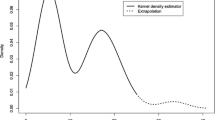Abstract
Seeds of the Japanese walnut, Juglans ailanthifolia, are usually scatter-hoarded by two rodent species, the Japanese squirrel Sciurus lis and the field mouse Apodemus speciosus, but only by the latter in several areas where S. lis is absent. We examined seed-size-mediated interactions of these three species across a wide geographic range. Field tracking of walnuts with miniature radio-transmitters revealed that squirrels hoarded larger seeds more frequently and at greater distances than smaller seeds. In contrast, mice hoarded smaller seeds more frequently and transported them farther than larger seeds. These seed dispersers could affect the evolution of seed size because seeds hoarded at sites farther from source trees are known to survive better until germination and as seedlings. We expect that larger seeds may be advantageous in regeneration if the main seed dispersers are squirrels, whereas smaller seeds may be advantageous if mice are the dominant dispersers. These predictions were supported by the fact that seed size was smaller on islands inhabited only by mice and at the edge of the squirrel distribution, compared to areas where mice and squirrels are both common.



Similar content being viewed by others
References
Abe H (2002) A guide to the mammals of Japan. Tokai University Press, Tokyo
Benkman CW (1995) The impact of tree squirrels (Tamiasciurus) on limber pine seed dispersal adaptations. Evolution 49:585–592
Benkman CW (1999) The selection mosaic and diversifying coevolution between crossbills and lodgepole pine. Am Nat 153:s75–s91
Benkman CW, Holimon WC, Smith JW (2001) The influence of a competitor on the geographic mosaic of coevolution between crossbills and lodgepole pine. Evolution 55:282–294
Brewer SW (2001) Predation and dispersal of large and small seeds of a tropical palm. Oikos 92:245–255
Clark DA, Clark DB (1984) Spacing dynamics of a tropical rain forest tree: evaluation of the Janzen-Connell model. Am Nat 124:769–788
Clarkson K, Eden SF, Sutherland WJ, Houston AI (1986) Density dependence and magpie food hoarding. J Anim Ecol 55:111–121
Coffey K, Benkman CW, Milligan B (1999) The adaptive significance of spines on pine cones. Ecology 80:1221–1229
Crawley MJ (2002) Statistical computing: an introduction to data analysis using S-plus. Wiley, West Sussex
Elliott PF (1974) Evolutionary responses of plants to seed eaters: pine squirrel predation on lodgepole pine. Evolution 28:221–231
Ellison AM (2001) Interspecific and intraspecific variation in seed size and germination requirements of Sarracenia (Sarraceniaceae). Am J Bot 88:429–437
Foster S, Janson CH (1985) The relationship between seed size and establishment conditions in tropical woody plants. Ecology 66:773–780
Gómez JM (2004) Bigger is not always better: conflicting selective pressures on seed size in Quercus ilex. Evolution 58:71–80
Hammond DS, Brown VK (1995) Seed size of woody plants in relation to disturbance, dispersal, soil type in wet Neotropical forests. Ecology 76:2544–2561
Hardin ED (1984) Variation in seed weight, number per capsule and germination in Populus deltoides Bartr. trees in southeastern Ohio. Am Midl Nat 112:29–34
Horikawa Y (1976) Atlas of the Japanese flora 2 (in Japanese). Gakken, Tokyo
Howe HF, Richter WM (1982) Effects of seed size on seedling size in Virola surinamensis: a within and between tree analysis. Oecologia 53:347–351
Hurley TA, Robertson RJ (1987) Scatterhoarding by terrestrial red squirrels: a test of the optimal density model. Can J Zool 65:1247–1252
Jacobsson A, Eriksson O (2000) A comparative study of seed number, seed size, seedling size and recruitment in grassland plants. Oikos 88:494–502
Jansen PA, Bartholomeus M, Bongers F, Elzinga JA, Ouden JD, Van Wieren SE (2002) The role of seed size in dispersal by a scatter-hoarding rodent. In: Levey DJ, Silva WR, Galetti M (eds) Seed dispersal and frugivory. CAB International, Wallingford, pp 209–225
Jansen PA, Bongers F, Hemerik L (2004) Seed mass and mast seeding enhance dispersal by a neotropical scatter-hoarding rodent. Ecol Monogr 74:569–589
Janzen DH (1982) Variation in average seed size and fruit seediness in a fruit crop of guanacaste tree (Enterolobium cyclocarpum). Am J Bot 69:1169–1178
Kirkpatrick RL, Pekins PJ (2002) Nutritional value of acorns for wildlife. In: McShea WJ, Healy WM (eds) Oak forest ecosystems. The Johns Hopkins University Press, Baltimore, pp 173–181
Koike S, Hazumi T, Furubayashi K (2003) Seed dispersal by the Japanese black bear (Ursus thibetanus japonicus) (in Japanese). Wildl Conserv Japan 8:19–30
Mezquida ET, Benkman CW (2005) The geographic selection mosaic for squirrels, crossbills and Aleppo pine. J Evol Biol 18:348–357
Minato M (1977) Japan and its nature (in Japanese). Heibonsha, Tokyo
Moegenburg SM (1996) Sabal palmetto seed size: causes of variation, choice of predators, and consequences for seedlings. Oecologia 106:539–543
Moles AT, Westoby M (2003) Latitude, seed predation and seed mass. J Biogeogr 30:105–128
Morse DH, Schmitt J (1985) Propagule size, dispersal ability, and seedling performance in Asclepias syriaca. Oecologia 67:372–379
Nihei Y (1995) Variations of behaviour of carrion crows Corvus corone using automobiles as nutcrackers (in Japanese). Jpn J Ornithol 44:21–35
R Development Core Team (2005) R: a language and environment for statistical computing. R Foundation for Statistical Computing, Vienna
Saito S, Miyaki M (1983) Growth of seedlings of Juglans ailanthifolia germinated from nuts seeded at different depths (in Japanese). Trans Meet Hokkaido Branch Jpn For Soc 32:219–222
Salisbury E (1974) Seed size and mass in relation to environment. Proc R Soc Lond B 186:83–88
Seiwa K (2000) Effects of seed size and emergence time on tree seedling establishment: importance of developmental constraints. Oecologia 123:208–215
Seiwa K, Watanabe A, Saito T, Kanno H, Akasaka S (2002) Effects of burying depth and seed size on seedling establishment of Japanese chestnuts, Castanea crenata. For Ecol Manage 164:149–156
Shibata M, Nakashizuka T (1995) Seed and seedling demography of co-occurring Carpinus species in a temperate deciduous forest. Ecology 76:1099–1108
Silvertown J (1989) The paradox of seed size and adaptation. Trends Ecol Evol 4:24–26
Smith CC, Fretwell SD (1974) The optimal balance between size and number of offspring. Am Nat 108:499–506
Sone K, Kohno A (1999) Acorn hoarding by the field mouse, Apodemus speciosus Temminck (Rodentia: Muridae). J For Res 4:167–175
Sota T, Takami Y, Kubota K, Ishikawa R (2000) Geographic variation in the body size of some Japanese Leptocarabus species (Coleoptera, Carabidae): the “toppled-domino pattern” in species along a geographic cline. Entomol Sci 3:309–320
Stapanian MA, Smith CC (1978) A model for seed scatterhoarding: coevolution of fox squirrels and black walnuts. Ecology 59:884–896
Stapanian MA, Smith CC (1984) Density-dependent survival of scatterhoarded nuts: an experimental approach. Ecology 65:1387–1396
Steele M, Knowles T, Bridle K, Simms E (1993) Tannins and partial consumption of acorns: implications for dispersal of oaks by seed predators. Am Midl Nat 130:229–238
Tamura N (1996) Application of a radio-transmitter for studying seed dispersion by animals. J Jpn For Soc 76:607–610
Tamura N (2001) Walnut hoarding by the Japanese wood mouse, Apodemus speciosus Temminck. J For Res 6:187–190
Tamura N (2004) Effects of habitat mosaic on home range size of the Japanese squirrel, Sciurus lis. Mammal Study 29:9–14
Tamura N, Shibasaki E (1996) Fate of walnut seeds, Juglans ailanthifolia, hoarded by Japanese squirrels, Sciurus lis. J For Res 1:219–222
Tamura N, Hashimoto Y, Hayashi F (1999) Optimal distances for squirrels to transport and hoard walnuts. Anim Behav 58:635–642
Tamura N, Katsuki T, Hayashi F (2005) Walnut seed dispersal: mixed effects of tree squirrels and field mice with different hoarding ability. In: Foreget PM, Lambert JE, Hulme PE, Vander Wall SB (eds) Seed fate. CAB International, Wallingford, pp 241–252
Theimer TC (2003) Intraspecific variation in seed size affects scatterhoarding behaviour of an Australian tropical rain-forest rodent. J Trop Ecol 19:95–98
Thompson JN (2005) The geographic mosaic of coevolution. The University of Chicago Press, Chicago
Vander Wall SB (1990) Food hoarding in animals. University of Chicago Press, Chicago
Vander Wall SB (1995) The effects of seed value on the caching behavior of yellow pine chipmunks. Oikos 74:533–537
Vander Wall SB (2001) The evolutionary ecology of nut dispersal. Bot Rev 67:74–117
Venable DL (1992) Size-number trade-offs and the variation of seed size with plant resource status. Am Nat 140:287–304
Wada N, Murakami M, Yoshida K (2000) Effects of herbivore-bearing adult trees of the oak Quercus crispula on the survival of their seedlings. Ecol Res 15:219–227
Wenny DG (2000) Seed dispersal, seed predation, and seedling recruitment of a neotropical montane tree. Ecol Monogr 70:331–351
Yamada H, Miyaura T (2005) Geographic variation in nut size of Castanopsis species in Japan. Ecol Res 20:3–9
Yamada H, Yamaguchi K, Miyaura T (2002) Effects of Japan sea climate on geographic distribution of Castanopsis sieboldii and C. cuspidata. J For Res 7:67–71
Yasuda M (2007) Notes on the Japanese squirrel Sciurus lis in Kyushu, southern Japan (in Japanese). Sciurid Inf 18:1–3
Acknowledgements
We thank K. Yoko-o, S. Seki, T. Ueyama, T. Kataoka, and C. Nishi for assistance in collecting walnut seeds. We also thank S. Suzuki and K. Tsuchiya for help with statistical analysis. Professor C.W. Benkman provided valuable comments to improve this manuscript.
Author information
Authors and Affiliations
Corresponding author
About this article
Cite this article
Tamura, N., Hayashi, F. Geographic variation in walnut seed size correlates with hoarding behaviour of two rodent species. Ecol Res 23, 607–614 (2008). https://doi.org/10.1007/s11284-007-0414-8
Received:
Accepted:
Published:
Issue Date:
DOI: https://doi.org/10.1007/s11284-007-0414-8




